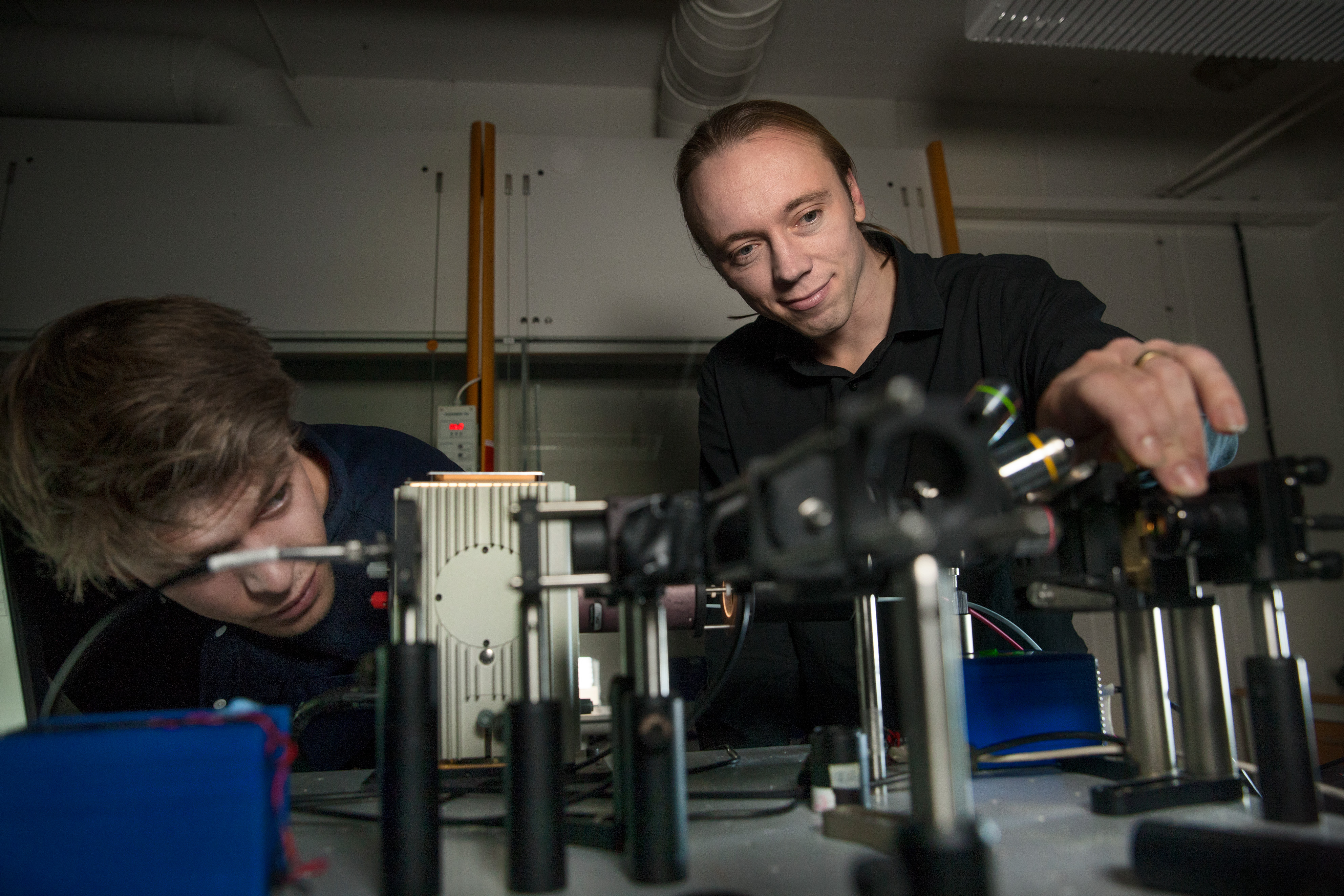Living cells are built so they can let exactly the right substances pass in and out through their membranes. Can the mechanism be copied? At Chalmers University of Technology Andreas Dahlin has accepted the challenge. He is creating smart filters capable of separating and capturing individual molecules.
Andreas Dahlin
Associate Professor of Nanochemistry at the Department Chemistry and Chemical Engineering
Wallenberg Academy Fellow 2015
Institution:
Chalmers University of Technology
Research field:
Nanopores in thin membrane, for separation and analysis of biomolecules
“Polymer-functionalized pores.” It is a complicated term, but is not as abstract as it sounds. Wallenberg Academy Fellow Andreas Dahlin at Chalmers’ Division of Applied Chemistry is attempting to create thin films with nanopores. Polymers – chains of molecules – are attached to each pore, serving as tiny gates. This means the pore is not merely an opening; it acquires a function.
“Natural cells are a good source of inspiration. Their membranes house numerous proteins that only allow certain molecules to pass, and block the way for others. It ought to be possible to create artificial systems capable of doing the same thing,” Dahlin explains.
Using ions to drill microscopic holes
The smart filters usually consist of a metal in combination with an insulating material. The two materials are interlayered in extremely thin films to form a membrane. The thickness of the layers can be controlled with a precision of one or two nanometers. At most they are about a hundred nanometers thick, i.e. one-thousandth of a millimeter. Dahlin and his colleague transform the membrane into a filter by drilling holes in it. But a normal drill cannot be used at this nanoscale. Instead, the researchers spread out nanoparticles on the surface, and then cover them with another film made of a fairly durable and protective material. When the particles are scraped off, they leave behind cavities in the protective film. The entire surface is then treated with ions, which react so strongly with the unprotected areas that holes form right through the membrane. The protective layer is then removed, leaving behind a membrane full of pores with a diameter of approximately 100 nanometers.
Finally, polymers bound to each pore, often by placing out a minute “initiator molecule”, which induces the polymer to build itself on the surface. The polymer is then intended to work as a gate that can be opened and closed.
Polymer form determines function
Much of Dahlin’s work is devoted to finding ways of inducing the affixed polymers to allow the desired molecules to pass through. For instance, there are polymers that change shape with temperature. One of the research team’s favorite polymers is elongated at room temperature, but only needs to be heated to 32 degrees Celsius to suddenly acquire quite different properties. It rolls into a little ball. In its elongated form the polymer closes the pores of the filter; when it shrinks it opens them. Changing the pH – the level of acidity – is another way of inducing the polymers to change shape.
“Polymers can also be combined, with a temperature-sensitive polymer on one side of the pores, and a pH-sensitive one on the other, for example. There are plenty of tricks we can use to control permeability,” says Dahlin.
“Being admitted as a Wallenberg Academy Fellow has given me a career at the university. I have doubled the size of my team, to the point where I really feel we are productive. Without the grant I would probably not be sitting here today.”
Studying individual proteins with the help of filters
A filter that allows selected molecules to pass has many biological, physical and chemical applications. It can distinguish one substance from another, or enable scientists to detect minute quantities of the substance in a mixture. The researchers are concentrating on filtering out proteins. In the future Dahlin also hopes it will be possible to capture individual proteins inside the pores, so they can be studied in greater detail to see how they behave under different conditions. At present, molecules are normally studied as a group, which in practice gives researchers average data on their behavior. Dahlin likens this to arriving at the average eye color for the population of Sweden. The answer would probably be “blue-brown” – which says very little about the actual color of people’s eyes.
“I am engaged in applied research; I am developing a new technique. But my dream is to enable us to learn more about how proteins work. If I succeed, the greatest benefit from my research may not be the application itself; it may be the basic scientific knowledge gained as a result of the application,” Dahlin enthuses.
Thinking up experiments
His molecule filter is giving him ample opportunity to do what he likes best as a researcher: designing new experiments. And he is happiest of all when he succeeds in thinking up the perfect experiment to obtain exactly the information the team want.
Dahlin has liked science and mathematics ever since his school days. But his favorite subjects varied over time. Perhaps that’s why he finds himself in an interdisciplinary research project that brings together chemistry and physics. But it was not a foregone conclusion that he would become and remain a researcher.
“When I was admitted as a Wallenberg Academy Fellow it made all the difference. Without the grant I probably wouldn’t be sitting here today. It’s hard to secure funding to employ as many researchers as I have working with me now. So perhaps I would have left research completely – chosen another path – become a teacher or stayed at home looking after the children.”
Text Lisa Kirsebom
Translation Maxwell Arding
Photo Magnus Bergström






